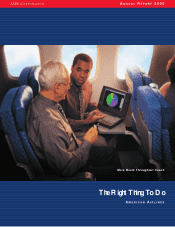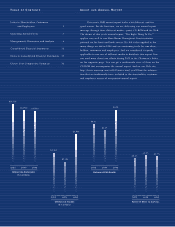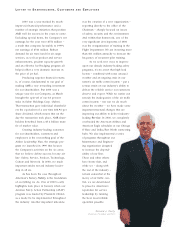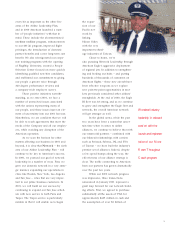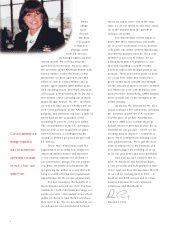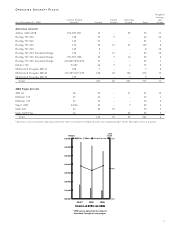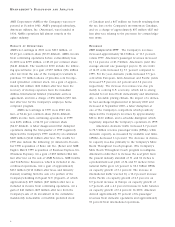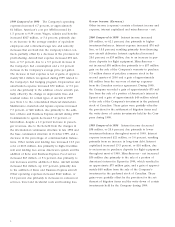American Airlines 2000 Annual Report Download - page 9
Download and view the complete annual report
Please find page 9 of the 2000 American Airlines annual report below. You can navigate through the pages in the report by either clicking on the pages listed below, or by using the keyword search tool below to find specific information within the annual report.
7
AMR Eagle’s passenger revenues increased
$158 million, or 12.2 percent. AMR Eagle’s traffic
increased to 3.7 billion RPMs, up 10.7 percent, while
capacity increased to 6.3 billion ASMs, or 10.9 percent.
The increase in revenues was due primarily to growth
in AMR Eagle capacity aided by a strong U.S. economy,
which led to strong demand for air travel, and a favor-
able pricing environment.
Cargo revenues increased 12.1 percent, or
$78 million, due primarily to a fuel surcharge imple-
mented in February 2000 and increased in October
2000 and the increase in cargo capacity from the addi-
tion of 16 Boeing 777-200ER aircraft in 2000.
1999 Compared to 1998 The Company’s revenues
increased $214 million, or 1.2 percent, versus 1998.
American’s passenger revenues increased by 0.1 per-
cent, or $12 million. American’s yield of 13.12 cents
decreased by 2.7 percent compared to 1998. For the
year, domestic yields decreased 1.1 percent, while
European, Pacific and Latin American yields decreased
7.2 percent, 6.0 percent and 4.5 percent, respectively.
The decrease in domestic yield was due primarily to
increased capacity, the labor disagreement during the
first quarter of 1999, and the impact of international
yield decreases on domestic yields. The decrease
in international yields was due primarily to weak
economies in certain parts of the world, large industry
capacity additions and increased fare sale activity.
American’s domestic traffic increased 2.1 percent
to 76.4 billion RPMs, while domestic capacity increased
4.1 percent. The increase in domestic traffic was due
primarily to the addition of Reno. International traffic
grew 4.6 percent to 35.7 billion RPMs on a capacity
increase of 3.1 percent. The increase in international
traffic was led by a 44.2 percent increase in the Pacific
on capacity growth of 44.1 percent and a 5.7 percent
increase in Europe on capacity growth of 7.3 percent,
partially offset by a 1.9 percent decrease in Latin
America on a capacity decrease of 5.1 percent. In
1999, American derived approximately 70 percent of
its passenger revenues from domestic operations and
approximately 30 percent from international operations.
AMR Eagle’s passenger revenues increased
$173 million, or 15.4 percent. AMR Eagle’s traffic
increased to 3.4 billion RPMs, up 20.9 percent, while
capacity increased to 5.6 billion ASMs, or 26.1 percent,
due primarily to the addition of Business Express in
March 1999.
OPERATI NG EX PENSES
2000 Compared to 1999 The Company’s operating
expenses increased 10.5 percent, or approximately
$1.7 billion. American’s cost per ASM increased by
10.5 percent to 10.38 cents, partially driven by a
reduction in ASMs due to the Company’s More Room
Throughout Coach program. Adjusting for this pro-
gram, American’s cost per ASM grew approximately
7.2 percent. Wages, salaries and benefits increased
$663 million, or 10.8 percent, primarily due to an
increase in the average number of equivalent employ-
ees and contractual wage rate and seniority increases
that are built into the Company’s labor contracts,
an increase of approximately $93 million in the
provision for profit-sharing, and a charge of approxi-
mately $56 million for the Company’s employee home
computer program. Aircraft fuel expense increased
$799 million, or 47.1 percent, due to an increase of
42.0 percent in the Company’s average price per gal-
lon and a 3.7 percent increase in the Company’s fuel
consumption. The increase in fuel expense is net of
gains of approximately $545 million recognized during
2000 related to the Company’s fuel hedging program.
Depreciation and amortization expense increased
$110 million, or 10.1 percent, due primarily to the
addition of new aircraft, many of which replaced older
aircraft. Maintenance, materials and repairs expense
increased $92 million, or 9.2 percent, due primarily to
an increase in airframe and engine maintenance vol-
umes at the Company’s maintenance bases and an
approximate $17 million one-time credit the Company
received in 1999. Commissions to agents decreased
10.8 percent, or $125 million, despite an 11.4 percent
increase in passenger revenues, due primarily to com-
mission structure changes implemented in October 1999
and January 2000, and a decrease in the percentage of
commissionable transactions.

